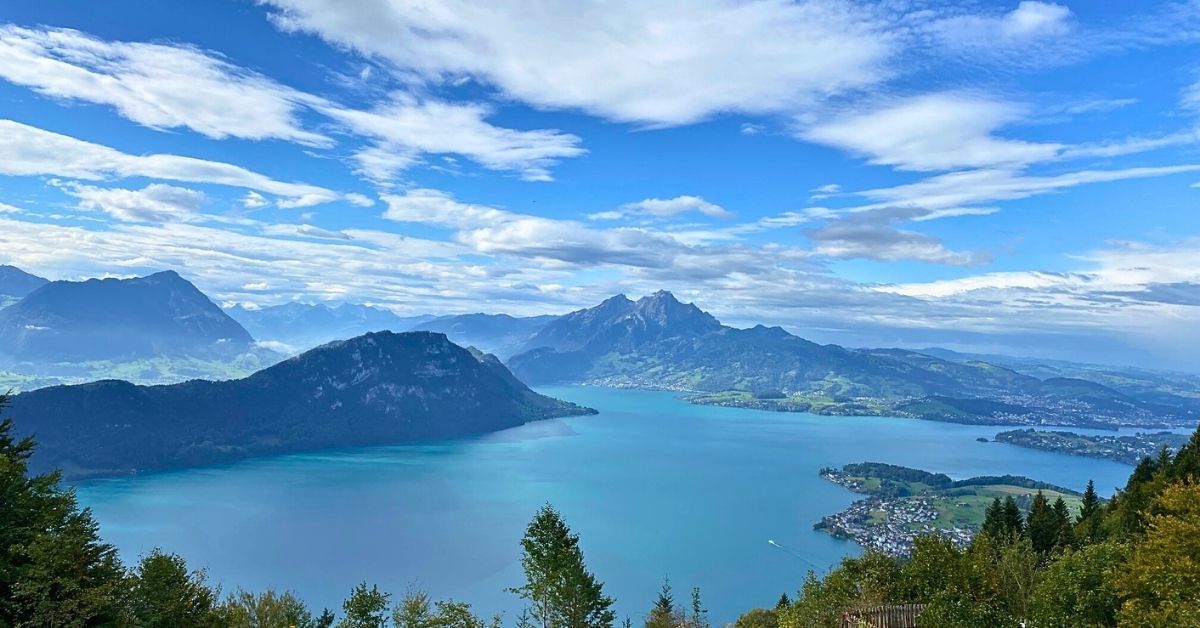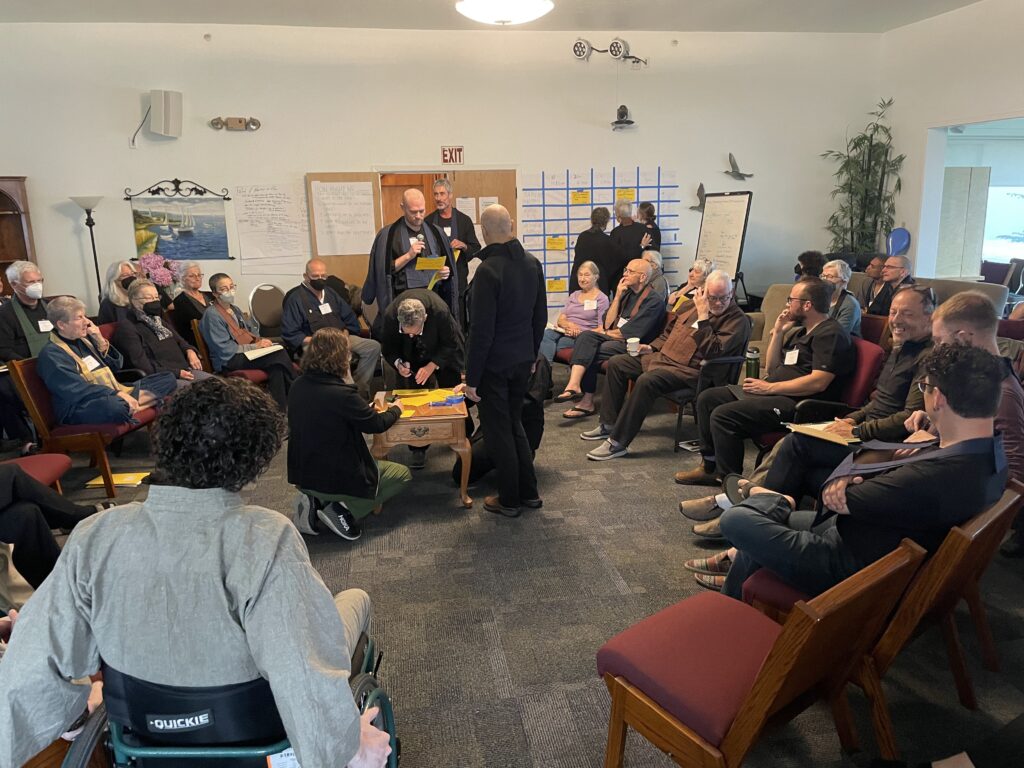In my role as Branching Streams Director, I recently had the great pleasure of visiting Zen Centers in Berlin and the Black Forest in Germany, and in and around Lucerne, Switzerland.
The initial impetus for my journey was an invitation from Tatsudo Nicole Baden, the Dharma heir of Zentatsu Richard Baker, to visit the Zen Buddhist Center in the Black Forest (ZBZS) after ZBZS became a Branching Streams affiliate. I reached out to Branching Streams teachers in Berlin and Lucerne and the trip came together.
I flew to Berlin on October 1 and spent a week there, staying with a Dharma friend, Ursula Richard. Ursula, a Zen priest ordained by Vanya Palmers, shares her practice of the Dharma in writing, teaching, and everyday life. She also translates Thich Nhat Han’s books into German and publishes Dharma books. Ursula met me at the airport in Berlin and demonstrated her familiarity with public transportation, as we changed trains several times to reach her neighborhood. During my time in Berlin we took buses and trains to attend classes, visit museums and see the Botanical Gardens, and after a few days I was able to find my way alone to several meetings with Zen friends.
Bernd Bender, the guiding teacher at Akazienzendo in Berlin, invited me to give a talk there. I had practiced for more than a decade with Bernd, who was ordained and given Dharma transmission by Dairyo Michael Wenger, at Tassajara, Green Gulch Farm, and City Center, and it was wonderful to see him leading the sangha.
Akazienzendo meets in an Aikido dojo which has been transformed into a zendo, with a familiar photo of Suzuki Roshi and black zabutons and zafus in rows. My talk fell on the night of October 3, which was Germany’s Reunification Day, commemorating the reuniting of East and West Germany and the dismantling of the Berlin Wall.
I shared an old Chinese folk tale, which is the focus of Koan 35 in the Mumonkan, The Gateless Barrier (translated and with a commentary by Robert Aitken). The story is also included in The Hidden Lamp, Stories from Twenty-Five Centuries of Awakened Women (edited by Florence Caplow and Susan Moon). The story tells of a young woman who is divided between loyalty to her parents and love for a man she has been close to since childhood; it illustrates the pain of separation, the longing for wholeness, and the energy released by reuniting — with forsaken parts of oneself, as well as with others.
The theme of reuniting ran through my entire time in Germany and Switzerland. It was joyful to see Bernd and Ursula again, and, when I got to Switzerland near the end of my trip, to be greeted by YoEn Auriau, with whom I had practiced at Green Gulch Farm and City Center. YoEn is now one of the guiding teachers at Felsentor, a Zen center on the side of a mountain above Lake Lucerne. I also reunited with the part of myself that had once been fluent in German (I studied German language and literature in college and spent nine months in Vienna during that time).
At the end of my week in Berlin, Ursula accompanied me to the train station and I took a train to Freiburg, where Richard Baker met me at the station. I rode with him and Nicole Baden through the countryside to the Zen Buddhist Center Black Forest, formerly called Johanneshof. We were warmly greeted and I was ushered to a room on the second floor which would be my home for the next five days. Nicole asked a long-time sangha member, Beata Aldag, to be my jiko. Beata filled me in on the history of ZBZS and accompanied me to the zendo, her flashlight shining the way in the dark to early morning and evening zazen.
I enjoyed blending in with the daily schedule, going to zazen and service, and participating in oryoki breakfast and dinner, and a study period. There was a talk by Richard Baker in the morning and an interactive seminar led by Nicole Baden in the afternoon. The focus of the seminar was Koan #21 from The Book of Serenity, “Yunyan Sweeps the Ground.” One evening I was invited to talk about what brought me to Zen practice and my work with Branching Streams.
I had several opportunities to speak with Richard Baker and Nicole Baden informally, as well as with a few long-time sangha members. As with many sanghas in the U.S., they were creating new program formats to attract new students to the center. Beata, who is their treasurer, is focusing on increasing the number of paid members. I appreciated the significance of Nicole Baden’s moving into the leadership of ZBZS. She will have a Mountain Seat ceremony and will become the Abbot in September 2024.
Beata kindly gave me a ride to the train station in Basel, and went inside to make sure I caught the train to Lucerne. I took a boat across Lake Lucerne, which is surrounded by mountains, and a funicular up a steep mountain to Felsentor. YoEn Auriau, a Swiss priest with whom I had practiced at Green Gulch Farm and City Center, met me when I descended from the funicular.
YoEn has received Dharma transmission from both Christina Lehnherr and Vanya Palmers, and is now the co-guiding teacher at Felsentor. She had many roles and tasks, including leading the daily staff meetings, teaching, talking with students, taking her turn at feeding the wood stove that heats the water and rooms, doing a dish shift, and welcoming visitors. I blended in with the schedule and enjoyed meeting the residents.
From a deck outside my room I could view the gardens below, the mountains encircling Lake Lucerne and the sky. The light changed continually, as clouds began to gather and rain and fog hid the mountains partially, then completely, then cleared.
Many hikers walk through the grounds of Felsentor on their way up or down the mountain, and stop at a small cafe for coffee or homemade treats baked by residents. Many of the hikers come to the zendo on Sunday evening when it is open to the public. The zendo at Felsentor was constructed by Paul Discoe and brought piece by piece by helicopter to its site in a large field. On the Sunday I was there, YoEn gave a brief talk and zazen instruction as there were some newcomers in addition to residents.
One afternoon, YoEn and I walked down the mountain a short way to visit a farm where two Zen students care for farm animals that have been saved from slaughter, including pigs, long-haired goats, cows, and chickens.
Although I only spent three days at Felsentor, I felt a strong connection with the place. After Sunday evening zazen, YoEn and I left for Lucerne. She introduced me to the Zendo am Fluss, a five-year-old zen center close to the Reuss River, which runs through Lucerne. The guiding teacher, Othmar Wuest, lives in an apartment above the zendo. YoEn was about to move into another apartment in the building, where I spent my last two nights in Europe. Zendo am Fluss is close to a centuries-old stone city wall, and I enjoyed exploring the neighborhood with many old trees and houses.
My roles during this journey were a mix of ambassador/emissary from SFZC, Zen student, Zen teacher, and friend. I am grateful for the warm welcome I received everywhere I visited and the opportunity to practice with four sanghas, urban and rural, feeling so at home in each place.
This article is cross-posted from the Sangha News Journal, please see the post there for more photos from the article.















